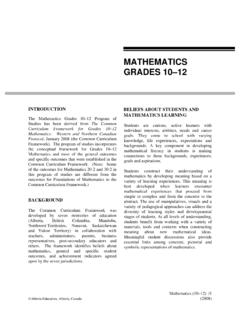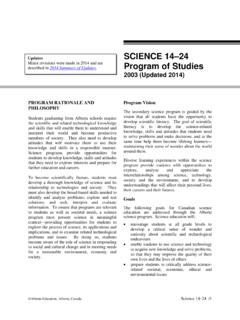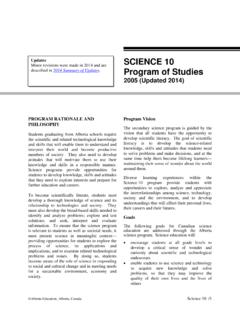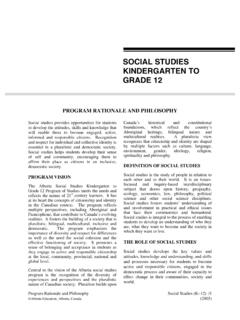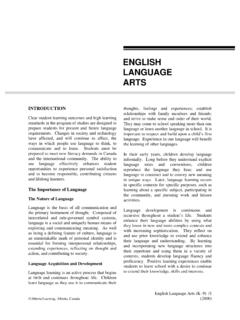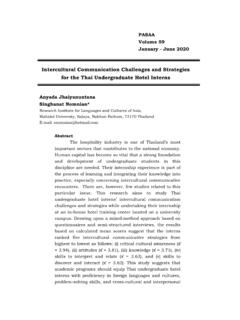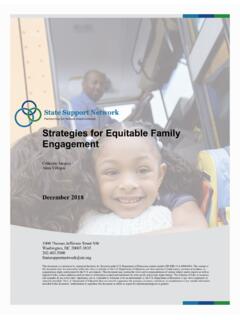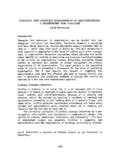Transcription of ENGLISH LANGUAGE ARTS - Alberta.ca
1 IntroductionEnglish LANGUAGE arts (Senior High) /1 Alberta Learning, Alberta, Canada(2003)INTRODUCTIONT here are two basic aims of senior high schoolEnglish LANGUAGE arts . One aim is to encourage, instudents, an understanding and appreciation of thesignificance and artistry of literature. A secondaim is to enable each student to understand andappreciate LANGUAGE and to use it confidently andcompetently for a variety of purposes, with avariety of audiences and in a variety of situationsfor communication, personal satisfaction appreciation of literature and an ability to uselanguageeffectivelyenhancestudents opportunities to become responsible, contributingcitizens and lifelong learners while experiencingsuccess and fulfillment in life.
2 As strong languageusers, students will be able to meet Alberta sgraduation requirements and will be prepared skills:the fundamental, personalmanagement and teamwork skills they need toenter, stay in and progress in the world of high school students must be prepared tomeet evolving literacy demands in Canada and theinternational Importance of Studying LiteratureThe study of literature allows students toexperience, vicariously, persons, places, times andevents that may be far removed from to reflect on the significance of culturalvalues and the fundamentals of human existence;to think about and discuss essential, universalthemes; and to grapple with the intricacies of thehuman condition.
3 The study of literature providesstudentswiththeopportunitytodeve lopself-understanding. They imagine the worlds thatliterature presents and understand and empathizewith the characters that literature studying Canadian literature, students are ableto reflect on ideas and experiences of citizenshipfrom Canadian study ofCanadian literature helps students to developrespect for cultural diversity and common studying works of literature, students come tounderstand how text creators use LANGUAGE toproduce effects, such as suspense, humour andpathos, and to create multiple layers of studying the craft of text creators, studentsdevelop their own creative and cognitive Importance of LanguageThe Nature of LanguageLanguage is the basis of communication and theprimary instrument of thought.
4 It is a social anduniquelyhumanmeansofexploringandcommu nicating well as being animportant element of culture, LANGUAGE is essentialfor forming interpersonal relationships, extendingexperience, reflecting on thought and action, andcontributing to ENGLISH LANGUAGE arts (Senior High)Introduction(2003) Alberta Learning, Alberta, CanadaLanguage DevelopmentLanguage development is their LANGUAGE abilities by using what theyknow, continuously and recursively, in new andmore complex contexts and with reflect on and use priorknowledge to extend and enhance their languageabilities and learning andincorporating new LANGUAGE structures into theirrepertoire and using them in a variety of contexts,students develop LANGUAGE fluency and Learning andEnglish LANGUAGE ArtsWhile students learn about LANGUAGE in all subjectareas and in contexts outside of school, Englishlanguage arts teachers have a central role inlanguage learning because of theirfocusonlanguage.
5 Its forms and its functions. It is theEnglish LANGUAGE arts teacher who helps studentsdevelop and apply strategies for comprehending,responding to and creating a variety of texts in avariety of Thinking and Learning throughLanguageCritical thinking, learning and LANGUAGE areinterrelated. Students use LANGUAGE to make senseof and bring order to their world and to play anactive role in various communities of learnerswithin and beyond the uselanguage to examine new experiences andknowledge in relation to their prior knowledge,experiences and beliefs. They make connections,anticipate possibilities, reflect upon and evaluateideas, and determine courses of critical thinkers, students also becomeindependent, successful and contributing membersof study helps students develop anawareness of the strategies that they use tocomplete learning tasks successfully and to talkabout, write about and represent themselves essence, the study of languageenables students to develop metacognition.
6 Itenables them to become more consciously awareof their own thinking and learning processes andto gain greater control of these , metacognition involves reflection,critical awareness and analysis, monitoring, who are engaged inmetacognition recognize the requirements of thetask at hand, reflect on the strategies and skillsthey may employ, appraise their strengths andweaknesses in the use of these strategies andskills,makemodifications,andmonitorsu bsequent of the specific outcomes in this program ofstudies emphasize metacognition. Students recalland describewhatthey have done in a particularsituation, and recounthow, then assess the value of the strategiesthey have used, make modifications to them orabandon them in favour of new approaches, andmonitor the use of these reworked or newstrategies in future ENGLISH LANGUAGE ArtsThe senior high school ENGLISH LANGUAGE artsprogram highlights six LANGUAGE arts listening,speaking,reading,writing, high school students engage all sixlanguage arts as they study texts and as they createtheir own texts in relevant situations for a varietyof purposes and of the languagearts are interrelated and interdependent.
7 Facility in one strengthens and supports facilityin the LANGUAGE arts (Senior High) /3 Alberta Learning, Alberta, Canada(2003)Listening and SpeakingOral LANGUAGE is the foundation of listening and speaking, individualscommunicate thoughts, feelings, experiences,information and opinions, and learn to understandthemselves and others. Oral LANGUAGE is used totell a community s stories and to convey many ofits values, beliefs and and speaking enable students to exploreideas and concepts, as well as to understand use oral LANGUAGE to learn, solveproblems and reach goals. To become discerning,lifelong learners, students need to develop fluencyand confidence in their oral LANGUAGE benefit from many opportunities to listenand speak, both informally and formally, for avariety of purposes and with a variety and WritingWritten LANGUAGE is a powerful means ofcommunicating and learning.
8 Reading and writingenable students to extend their thinking and theirknowledge and use of LANGUAGE , to increase theirunderstanding of themselves and others, and toexperience enjoyment and personal provides students with a means ofaccessing the ideas, perspectives and experiencesof others. By using effective reading strategies ,studentsconstructmeaningandde velopthoughtfulandcriticalunderstandings andinterpretations of a variety of texts. They also usereading strategies to reconstruct the meanings enables students to explore, shape andclarify their thoughts and to communicate thesethoughts to using effective writingstrategies, students discover and refine ideas, andcompose and revise with increasing confidenceand and RepresentingVisual imagery is an integral part of contemporarylife.
9 By developing viewing strategies and skills,students come to understand the ways in whichimages may be used to convey ideas, values viewing enables students toacquire and assess information, appreciate theexperiences of others, and understand andevaluate others ideas and may be envisioned as the expressivecounterpart of representationenables students to communicate their ideasthrough a variety of text forms, including posters,diagrams,photographs,collages,vi deopresentations, visual art, tableaux and , however, extends beyond the example, representations may have an speaker s tone of voice canconvey, or represent, his or her feelings and sound effects that areselected to accompany a dramatic monologue, adialogue or a readers theatre presentation may berepresentational in that they set a mood andconvey an is also manifested in print.
10 Tablesand figures that accompany informative texts maysuggest spatial relationships, time sequences, andrelationships between and among concepts andideas. Posters and other examples of promotionalprint texts typically employ design principles,such as alignment and repetition, to representrelationships and to create ENGLISH LANGUAGE arts (Senior High)Introduction(2003) Alberta Learning, Alberta, CanadaText and ContextBroadening the Definition of Text This program of studies defines the word text texts that senior high schoolstudents study in their ENGLISH LANGUAGE artscourses include works of literature and other textsin oral, print, visual and multimedia also create texts in a variety of forms texts include storytelling, speechmaking,discussion and conversation.

